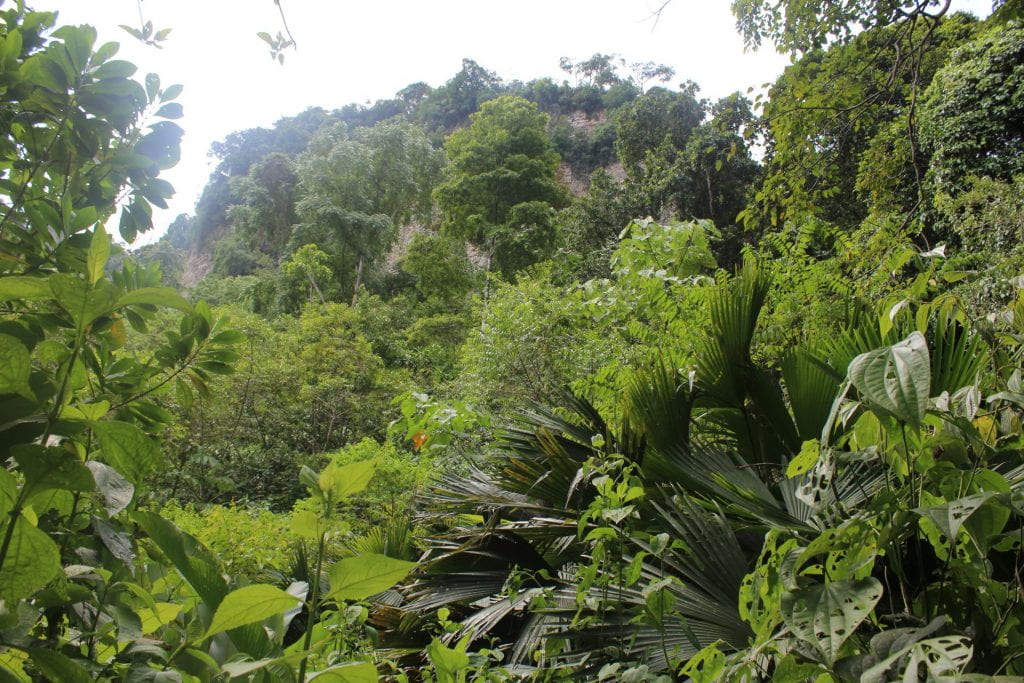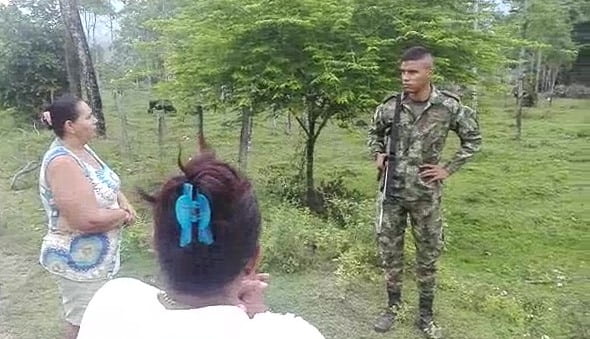Naomi Millner and Monica Amador.
During the COVID-19 lockdown the Colombian national army moved in and out of forested conservation areas. We followed these movements over the past year and have seen that the pandemic formed a moment for the government to strengthen pockets of exceptional rule – in other words, a mode of ‘emergency’ governing that legitimises exceptional interventions and paramilitary involvement. As in recent and colonial history of Colombia, this form of rule centres on a spatial imagination that sees rural migrants as a source of risk and threat that needs to be contained.
One of the ‘good news’ media narratives that circulated during the first months of the COVID-19 pandemic in 2020 was the positive impact of national lockdowns across the world on the environment. Stories proliferated of the increase of bird populations in cities (Washington Post, 2020), the closing of ozone holes related to aerial pollution (Arora et al, 2020), and the decrease of smog in normally congested urban areas, improving air quality (BBC, 2020). However, by May 2020 it also became clear that deforestation in areas of the world’s highest biodiversity, such as the Amazon and Andean biomes in Latin America, were being affected in an opposite sense. Remote sensing platforms in Colombia recorded a sudden acceleration in deforestation rates, reversing trends of gradual reduction achieved over the past few years (Mongabay, 2020).
In popular readings of this spike, deforestation was increasing because national armies were moving out of forests and into urban centres to police the new lockdown regulations. But such narratives ignore the fact that the armed forces actually increased their presence in some protection areas during this period, while in others there was already a relative lack of state protection. A closer look reveals how the pandemic has served as an opportunity for historical patterns of control and state abandonment to be intensified.
Our qualitative and sociohistorical research, alongside interdisciplinary work by a cross-institutional team (see Amador Jiménez et al., 2020),links current trends in deforestation with longer histories of militarization and mobility. The national army in Colombia has long been deployed in uneven ways across the country’s areas of high forest biodiversity, depending on the coding of parts of the countryside as well-organized and peaceful, and others as risky and potentially insurgent. On the one hand, this may be associated with the extended internal armed conflict (1964–2016, and ongoing), when different areas of the countryside became associated with guerrilla groups and paramilitary forces, conferring the stigma of these groups on local peasants in an enduring way. On the other hand, the ways that forest governance and military presence combine recall longer histories of coloniality and moral coding, which Taussig (2007[1987]) calls ‘moral topographies’.
In the colonial imagination, the lowlands were consistently viewed as places of heat, humidity and suspicion, whereas the highlands – where the capital Bogotá is situated – were associated with an organised peasantry and qualities of moral resilience. This spatial imaginary persists today in an entrenchment of such stereotypes through the way that conservation policies are designed and implemented.

During lockdown, however, the movement of the armed forces was not only away from rural and into urban areas. In some rural regions – such as the Andean high forest close to Bogotá – the low military presence remained about the same, with those troops distributing sanitary and food supplies. However, in the Serranía de las Quinchas protected area in the low Andean forest – one site where we conducted fieldwork for our interdisciplinary BioResilience project – the presence of the military increased, in association with a renewed drive of coca eradication campaigns. Such campaigns are part of a scheme called Operation Artemisa, which combines an intensification of the war on drugs (specifically coca production intended for the cocaine trade) with the policing of illegal timber cutting.
Meanwhile, in the Amazon forest armed forces were drastically reduced, affording illegal armed groups greater capacity to coerce local peasants into large-scale illegal deforestation. However, what media accounts miss in this third case is the way that governance had already been weakened by the historical framing of peasants – especially recent migrants – as part of the cause of deforestation, rather than as victims.
At the heart of such spatial imaginations is a differentiated view of the rural poor, which distinguishes largely settled, highland communities of peasants – called campesinos [peasant farmers] – from rural migrants, or colonos [landless peasants], displaced by conflict or poverty, who live by expanding agricultural frontiers. The figure of the colono emerged during a period of conflict called La Violencia [‘the Violence’ (1948 -1958)], when peasants were stripped of their lands by internal conflict. During the 1960s and 1970s, colonos were depicted as hardworking people, the protagonists of ‘progress’ willing to adapt and display creativity despite difficulties. However, colonos were also portrayed as those who endlessly moved on and lived by ‘cutting down the jungle’.
In subsequent decades this stigma was consolidated as colonos were re-constituted as ‘internal enemies’ of the state, associated with insurgency (Fajardo, 2006). More recently, colonos in other parts of Latin America have been made equivalent to potential nature-destroyers whose practices do not fit the images of the ‘green peasants’ (Ojeda, 2012) or ecological indigenous peoples (Ulloa, 2017) promoted by environmental conservation. While the campesinos of the highland are imagined as potential green subjects, the colonos of the lowlands are associated with mobility and threat to the environment. One problematic effect of this framing is to blur together displaced people and migrants with other actors, such as drug-traffickers and illegal timber-cutters, who often are themselves enacting violence toward marginal and displaced populations.
In prioritizing forced coca eradication during the lockdown in places like the Serranía de las Quinchas – a protected forest area in the Middle Magdalena region mainly inhabited by colonos – the Colombian government and its army also demonstrate that, rather than being under-resourced to police deforestation, they are able to exploit the extraordinary conditions to intensify spatial control in such ways. As well as generating clashes with rural communities and permitting illegal deforestation to take place unchecked, this has resulted in the infringement of peasant civil rights and an increase in murders of social leaders in the forests of the inter-Andean valleys a such as Cauca, Nariño, Catatumbo and Quinchas (Semana Sostenible, 2020; Indepaz, 2020). Much of this violence is taking place as part of military operations under the conditions of exceptionality associated with the pandemic – avoiding controversy and contestation by social organizations and human rights defenders.

out forced coca crop eradication (image: from video shared by the community)
Such conditions of exception are also at play in regions of the Amazon forest where large communities of colonos have settled. Here, environmental entities have stressed the idea of colonos as an ‘internal enemy’ of the environment, who need to be controlled to achieve environmental outcomes. This idea has enabled the state to create arguments for the introduction of extraordinary control measures, on the basis that managing the colono problem will enable the wars against deforestation, coca cultivation and counterinsurgency deforestation simultaneously. Operations such as Artemisa are premised on the notion that colonos are intrinsically eco-destroyers and are indistinguishable from the illegal armed groups operating in the region. This renders it practically impossible for local peasants to appeal to the law to resist harassment by the army.
The reality on the ground is, of course, quite different. The mafia groups controlling large-scale deforestation and drug operations coercively employ local colonos on even greater scales when the state military is withdrawn. This is especially the case because many international environmental institutions are located far from where rural communities live, partly due to narratives about the violence and instability of the colonos. During lockdown, when the army was significantly redeployed elsewhere, the precarious hold of the state on illegal logging fell apart.
In parts of the Colombian Amazon, where the state already had a limited presence, illegal armed groups, described by local environmental organizations as ‘land grabbers’ and ‘mafias come bosque’ [forest-devouring mafias] strengthened their territorial control and expanded their deforestation activities. This coerced labour reveals itself in a pattern of deforestation that manifests in large square blocs, unlike the piecemeal agriculture associated with the colonos’ own subsistence practices. This has given way to the fresh empowerment of illegal armed groups to enforce a local rule of law, reviving conditions of exceptional rule that were enabled during earlier periods of the armed conflict.

